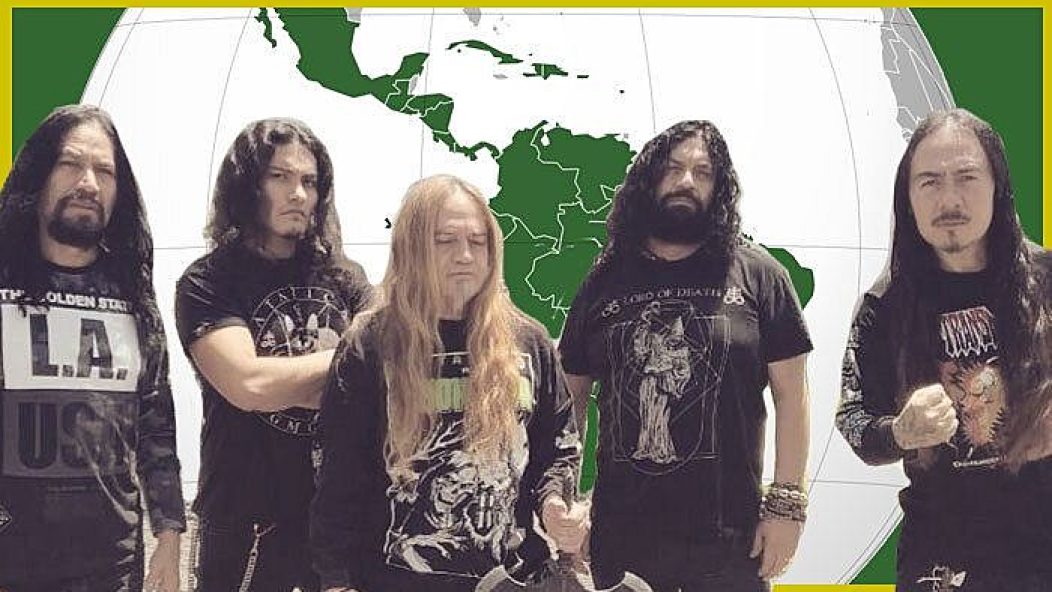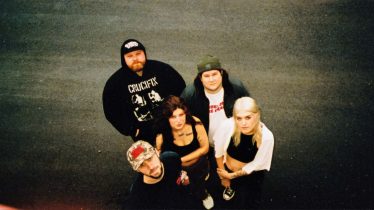
30 metal bands who pioneered heavy music in Latin America
Heavy metal is most often viewed as a Westernized genre of music. While bands such as Black Sabbath, Judas Priest and Iron Maiden get their fair share of credit for creating the genre, others in different parts of the world are overlooked. Latin metal in particular has a long and fruitful history that largely gets pushed to the wayside.
Whether it’s thrash, black, death or plain old classic heavy metal, Latin metal bands have been just as much a part of the history of the genre as their Western counterparts. They simply haven’t received the same level of exposure for numerous reasons.
Read more: Relive Underoath’s electrifying ‘Lost In The Sound Of Separation’ set
Countries in Latin America experienced harsh debt crises throughout much of the early days of metal’s foundation as well as faced authoritarian governments, which imposed censorship, brutality against citizens and many other human rights violations. With harsher living situations and fewer resources, many bands don’t have recorded material for years despite mass local popularity, while Western bands had their music explode with international consumption.
For reasons like this, lyrical topics from Latin metal bands are typically much more extreme in regards to lived experiences than American counterparts. That’s not to discount what others have lived through, but rallying cries for social reform in Latin metal cut deep, coming from a time of extreme turmoil for citizens of those countries. Nevertheless, they persevered to create unity among the outcasts of these regions with what they had available and left their stamp on history.
Take a look below for 30 Latin metal bands who helped create, shape and mold the history of the genre.
Broncco
HQ: San Salvador, El Salvador
Facebook | Twitter | ReverbNation
El Salvador didn’t experience a boom of rock and heavy-metal bands like many parts of the world throughout the ’80s due to the Salvadoran Civil War, but in the mid-’70s, Broncco laid the groundwork for the country’s ’90s extreme-metal surge. Their sound lies closer to the shimmer of glam metal than the extreme noises bands produced following the end of the war in 1992, but their lyrics about youth angst and a lust for freedom were an early indicator of the themes prevailing throughout El Salvador’s metal scene.
C.R.Y.
HQ: Ambato, Ecuador
Facebook | SoundCloud | Discogs
Inspired by the European extreme-metal scene of the late ’80s, Ecuador’s C.R.Y. (an acronym for “Cremacion Resurrection Y”) were one of the earliest examples of black/death metal in the country. They recorded a handful of songs in the ’90s with the typical lo-fi production style of the genre at the time. Luckily, their influence was cemented in 2014 by the Ministry of Culture and Heritage of Ecuador through a re-recorded track for a compilation of 16 of the country’s flagship rock and metal bands.
Dorso
HQ: Santiago, Chile
Facebook | YouTube | Spotify
With bands such as Celtic Frost and Venom raising the bar for extremity in metal, others took notice and followed in their path, including Chilean bands. Dorso, as well as peers such as Pentagram Chile or Massakre, brought with them a new speed-metal sound, rivaling well-known peers (Slayer, Metallica), though quietly due to the dictatorial rule and censorship from General Augusto Pinochet until 1990.
Enslaver
HQ: Panama City, Panama
Discogs
Panama’s metal scene was almost nonexistent until the tail end of the dictatorial rule of Gen. Manuel Noriega in 1989. This developmental delay affected what would become the earliest sounds of their underground music scene, though, as the extreme-metal boom of the late ’80s and early ’90s influenced bands such as Enslaver to dish out doomy, blistering death metal. They disbanded in 1996, just eight years after beginning, but members formed several other death-metal bands, showing extremity would prevail throughout the majority of the country’s metal scene.
Gilgamesh
HQ: Mexico City, Mexico
Facebook | Discogs
Though they didn’t record much music, Mexico’s Gilgamesh marked a massive milestone in 1992 by becoming the country’s first-ever death-metal band comprising all women. Their 1995 demo flexed a visceral pack of death-metal songs laced with elements of doom metal before they disbanded in 2000. Luckily, Gilgamesh reunited in 2014 to deliver devastating sounds once again.
Godless
HQ: Sabana Grande, Puerto Rico
Facebook | Instagram | Bandcamp
While the origins of black metal are typically focused on Europe, Godless have been summoning satanic sounds since 1989. They’re Puerto Rico’s first-ever black-metal band and released several demos throughout the ’90s before cleaning up their production for a modern sound throughout the past couple of decades.
Graf Spee
HQ: Montevideo, Uruguay
Facebook | Discogs
With Brazilian bands Sepultura, Sarcófago and Volkana finding success in harsher takes on thrash metal, many Latin metal bands changed up their style to match their peers. Graf Spee are a prime example of that, shifting from the classic heavy-metal tone of their beginnings to a much more aggressive approach. The band represent the earliest incarnation of metal in Uruguay, but with their shift in the latter half of the ’80s, the new pack of Uruguayan metal bands followed suit.
Hermética
HQ: Buenos Aires, Argentina
Facebook | Spotify | Discogs
Argentina has enjoyed a long history with metal, starting with Riff, who gained mainstream success in the country in 1980. The next decade saw ups and downs, with bands facing difficulties in establishing themselves. The ’90s saw a resurgence, with bands such as Hermética fusing thrash with Argentine folk roots. They broke up in 1994, but members ended up forming successful bands such as Almafuerte and Malón.
Khaos
HQ: San Pedro Sula, Honduras
Facebook | Twitter | Spotify
Honduras has a respectably sized metal scene for a country of fewer than 10 million people, and Khaos are the band who opened that possibility. Though they only recorded one album before splitting in 1985, they brought influence from the new wave of British heavy metal scene to Honduras at a time when rock or metal bands were known for playing covers instead of crafting original songs.
Korzus
HQ: São Paulo, Brazil
Facebook | Instagram | Spotify
Korzus are widely considered to be one of the first Brazilian thrash metal bands, along with their peers Sepultura and Sarcófago. They quickly gained attention through their extreme, speedy riffs and association with Sepultura as well as Los Angeles speed-metal band Agent Steel. They then switched to a more popular Bay Area thrash sound in the vein of Death Angel and achieved success. Korzus are still active today, with several new records coming out in the past two decades.
Kraken
HQ: Medellín, Colombia
Facebook | Instagram | Spotify
Colombia’s music scene experienced a surge of rock bands in the ’60s due to globalization and foreign musical influences. With some time, this expanded to include metal, too. By 1984, Kraken formed as one of the pioneering metal bands in the country, leading the way for other acts to expand the genre, from classic metal to more extreme sounds such as black or death metal. Band leader Elkin Ramírez passed away in 2017, but they’re carrying on strong with Roxana Restrepo fronting the band in his honor.
Kranium
HQ: Lima, Peru
Facebook | Instagram | Bandcamp
Peru experienced rock music in the ’70s exclusively through underground outlets due to a ban from Gen. Juan Velasco Alvarado. These frustrations led to a strong underground music scene in the ’80s. Punk music became a major influence, but death metal also started to develop, with bands such as Kranium leading the way. They couldn’t afford to record music for almost a decade together but released several demos in the ’90s while incorporating pan flutes and other traditional instruments into their sound.
Luzbel
HQ: Mexico City, Mexico
Facebook | Twitter | YouTube
Originally known as Red, Luzbel brought the new wave of British heavy metal sound back to Mexico after failing to succeed in England and rebranding back home. This paid off massively as their sound and skills brought them a raging and eager fanbase ready to latch onto local bands pumping out an international sound that was becoming a huge musical movement at the time.
Maleficia
HQ: Managua, Nicaragua
Facebook | Twitter | Bandcamp
Nicaragua doesn’t have much metal throughout their history with the genre’s beginnings there, starting after the Contra war’s conclusion in 1990. Rock and metal have started to gain popularity among youth, though. For Nicaraguan metalheads in the ’90s, death metal was the preferred flavor. Maleficia, who formed from some members’ previous band Maligno, hold some of the earliest recordings of death metal from the country and have put out numerous releases in the past decade.
Mantra
HQ: San José, Costa Rica
Facebook | Discogs | YouTube
While Costa Rica is a small country, there’s plenty of metal to be found. Going back to the ’80s, they even managed a small but strong death-metal scene. Mantra are one of the earliest bands from the country to pop out blazing death thrash. Although they didn’t have recorded material for years, they struck success with a string of albums in the ’90s and a resurgence in the 2000s.
Mortem
HQ: Lima, Peru
Facebook | Discogs
With the Peruvian extreme-metal movement massively growing in the late ’80s, Lima had a surge of bands cropping up. While many have disbanded, Mortem remain one of the pioneers of the scene. They were the first Peruvian metal band to tour Europe and the U.S., bringing attention to the country’s burgeoning death-metal domain and their continuously solid blast of ear-piercing releases.
Massakre
HQ: Santiago, Chile
Facebook | Discogs | Spotify
Along with Dorso, Massakre helped bring new, heavier sounds to Chilean metal with faster riffs, harsher vocals and a previously unseen level of aggression. Since their formation in 1982 as Sepulcro, they’ve gone through a few name and style changes but settled into their sound as Massakre and continue to produce whiplash-inducing thrash metal.
Parabellum
HQ: Medellín, Colombia
Discogs
As Colombia’s metal scene expanded in the late ’80s, it took on a more visceral sound, with death metal and thrash metal becoming the prevalent choice for bands. Parabellum are widely considered to be the country’s first extreme-metal band as well as one of the first black-metal outfits to exist. They paved the way for dozens of other acts to start playing metal following their releases in the late ’80s, including locals as well as European bands such as Mayhem.
Rata Blanca
HQ: Buenos Aires, Argentina
Facebook | Instagram | Spotify
Largely considered the most well-known metal band in Argentina, Rata Blanca made a splash on the scene, starting in 1986 through classic, rip-roaring heavy metal. Their sophomore album, Magos, Espadas y Rosas, is the best-selling Argentinian heavy-metal record, and the band are still active today, with founding guitarist Walter Giardino leading the band.
Rawhide
HQ: Asunción, Paraguay
Discogs
Although Nash predated Rawhide as the first metal band in Paraguay, they opted for a more popular, lighter metal tone in the vein of Iron Maiden instead of blistering thrash like Slayer. Rawhide guitarist Emilio Paredes says Slayer’s Hell Awaits was revolutionary. They set out to be the first musicians in the country playing that style and did so with a raw fury that changed metal in Paraguay.
Resistencia
HQ: Caracas, Venezuela
Facebook | Discogs
As rock and metal music made its way across the world, ’70s bands such as Judas Priest and Iron Maiden became massively influential, particularly in Latin countries. The internet wasn’t a thing yet, but bands could take the records they heard and emulate the sound while inspiring a local following. Resistencia are a prime example of making something from nothing. They’re considered one of the first Latin metal bands but built an audience big enough to move from pubs to amphitheaters when Venezuela had no metal scene.
Sanctum Regnum
HQ: Guatemala City, Guatemala
Facebook | Discogs | Instagram
Heavy metal in Guatemala didn’t really take off until the ’90s, but a small group of bands were ahead of the pack in the ’80s. Most stuck to classic metal, but Sanctum Regnum launched death metal into the scene in 1988, with dozens following in their footsteps in the years after they began. They didn’t manage to record anything until 1994 and broke up after just two albums and two demos, but their legacy lives on through the continuously growing extreme-metal movement in Guatemala.
Sarcófago
HQ: Belo Horizonte, Brazil
Facebook | Spotify | Discogs
As one of the originators of extreme metal in Brazil, Sarcófago were revolutionary to the development of Latin metal. The band were fronted by original Sepultura vocalist Wagner Lamounier after he left the group in 1985, and their black-metal sound became a pinnacle of the genre. Their debut album, I.N.R.I., was one of the biggest influences on the European-rooted second wave of black metal, while the album cover inspired the corpse paint aesthetic.
Sepultura
HQ: Belo Horizonte, Brazil
Facebook | Instagram | Spotify
The influence of Sepultura on Latin metal cannot be overstated—the band hold the place of the most internationally renowned of all Latin metal bands. From their breakthrough with 1989’s Beneath The Remains to their iconic melding of traditional Brazilian instruments with thrash and nü metal on Roots, Sepultura made the dream of becoming a successful band from Latin America a possibility. They’ll forever hold a place as one of the most important bands in heavy-metal history.
Stress
HQ: Belém, Brazil
Facebook | Discogs
Before thrash metal took over Brazil’s metal scene, classic speed metal was the flavor choice of the originators in the country. Stress are held as one of the first metal bands from the country and have the earliest recorded metal album of any Brazilian band. Their self-titled debut sounds like Motörhead or Saxon while addressing social issues, censorship and government torture.
Subvertor
HQ: La Paz, Bolivia
Facebook | ReverbNation | Discogs
Though Bolivia didn’t have much metal to speak of prior to the ’90s, classic metal and thrash started cropping up in La Paz toward the end of the ’80s. Once Black Mass broke thrash into the country, the door was open for more extreme sounds to take over. Subvertor conjured the country’s earliest grindcore and death metal, bringing new meaning to what constituted a heavy sound for Bolivians.
Tendencia
HQ: Pinar del Río, Cuba
Facebook | Twitter | Spotify
Much like Sepultura’s revolutionary melding of traditional Brazilian instrumentation with metal on Roots, Tendencia took Afro-Cuban rhythms and mixed them with groove metal throughout the ’90s into today. They’re one of the most notable rock or metal bands in Cuba, having won several national awards, headlining local festivals and continuously growing their sound and audience.
Transmetal
HQ: Yurécuaro, Mexico
Facebook | Bandcamp | Spotify
With thrash metal at its peak in the late ’80s, bands all across the world were trying to achieve the same level of success as leaders such as Metallica or Slayer. In Mexico, Transmetal helped revolutionize the subgenre. Their death-thrash sound earned them a strong following, which eventually turned into performing alongside legendary bands such as Kreator, Slayer, Sepultura and more as well as releasing dozens of albums over the past three decades.
Ultimatum
HQ: Mexico City, Mexico
Facebook | YouTube | Spotify
As one of Mexico’s first metal bands, Ultimatum already hold a strong status in Latin metal history, but they’ve also spearheaded the movement of women in the scene. Their debut record featured Marcela González’s hard-hitting vocals before she left. She was replaced by Brenda Marín, who’s one of the most notable women in Latin metal, having led some of Mexico’s finest bands. Ultimatum even reunited in 2015, with González returning to the microphone for live shows and to release a brand-new album in 2020.
Volkana
HQ: Brasília, Brazil
Facebook | YouTube | Discogs
Brazilian thrash metal, like the vast majority of the genre, was overwhelmingly male-dominated. Volkana prove women can play just as hard through their absolutely chaotic, face-melting music. Their shredding sound is heavy enough to rival their male peers, but they showed enough diversity to receive airplay on MTV. Though they broke up in 1996, Volkana regrouped in 2008 for live shows and one-off recordings.










